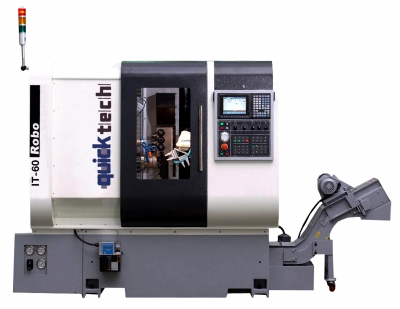
Quicktech i-42 ROBO and i-60 ROBO 4-axis mill/turn centers feature integrated 6-axis Mitsubishi robots for fast, automated loading and unloading of medium-diameter (i42: 42mm/1.68", i60: 60mm/2.36") bar stock. In addition to carrying out highly productive turning, the machines can perform complex milling with standard live tools, according to the company. An optional 360˚ B-axis further extends milling capabilities. The machines are distributed in North America exclusively by Absolute Machine Tools Inc.
The Mitsubishi S-series 6-axis high-speed robot automatically loads, unloads or turns over parts weighing up to 13 lbs. An optional multiple-tray pallet handling system enables untended operation. The robot is contained within the machine and is positioned to allow unimpeded operator access for machine setup and operation.
The i-42 ROBO and i-60 ROBO machines operate in 4 axes (5 with the optional B-axis), with a 15-hp high-torque turning spindle that features C-axis capability, a 2-hp live tool milling spindle, and capacity for 17 tools (23 with B-axis). A standard DIN-173-42B collet chuck provides capacity for 42mm bar, while an optional with a 60mm collet or 6", 3-jaw chuck offers 60mm bar capacity.
The machines’ innovative tooling arrangement provides partmaking flexibility and efficiency. A 3-axis (4-axis with optional B-axis) gang-type vertical tool post serves the main spindle with 6 O.D. turning tools, 5 I.D. turning tools, and 3 radial and 3 axial live tool heads. The tool post also provides Y-axis motion for off-center milling operations. Rigid tapping is standard, as is the Kennametal KM-25 quick-change system that minimizes tool change time.
A matched CNC system combines a Mitsubishi M80A control, featuring a 260mm (10.4") LCD, with Mitsubishi servomotors and amplifiers for top reliability and performance. Standard machine features include a bar feeder interface, parts conveyor and catcher, chip conveyor, collet chucks and a 400-psi coolant pump.
Machine frames and all major components are heavy Meehanite cast iron. In addition, the i42 and i60 ROBO machines utilize large 35mm Hiwin roller type linear guideways and double-anchored, pre-tensioned 32mm ballscrews.
Steve Ortner, president and owner of Absolute Machine Tools, said, “Robotic part handling combined with the speed, efficiency and flexibility of the Quicktech i42 and i60 turn/mill centers creates an integrated, highly productive manufacturing package.”
Contact Details
Related Glossary Terms
- centers
centers
Cone-shaped pins that support a workpiece by one or two ends during machining. The centers fit into holes drilled in the workpiece ends. Centers that turn with the workpiece are called “live” centers; those that do not are called “dead” centers.
- chuck
chuck
Workholding device that affixes to a mill, lathe or drill-press spindle. It holds a tool or workpiece by one end, allowing it to be rotated. May also be fitted to the machine table to hold a workpiece. Two or more adjustable jaws actually hold the tool or part. May be actuated manually, pneumatically, hydraulically or electrically. See collet.
- collet
collet
Flexible-sided device that secures a tool or workpiece. Similar in function to a chuck, but can accommodate only a narrow size range. Typically provides greater gripping force and precision than a chuck. See chuck.
- computer numerical control ( CNC)
computer numerical control ( CNC)
Microprocessor-based controller dedicated to a machine tool that permits the creation or modification of parts. Programmed numerical control activates the machine’s servos and spindle drives and controls the various machining operations. See DNC, direct numerical control; NC, numerical control.
- coolant
coolant
Fluid that reduces temperature buildup at the tool/workpiece interface during machining. Normally takes the form of a liquid such as soluble or chemical mixtures (semisynthetic, synthetic) but can be pressurized air or other gas. Because of water’s ability to absorb great quantities of heat, it is widely used as a coolant and vehicle for various cutting compounds, with the water-to-compound ratio varying with the machining task. See cutting fluid; semisynthetic cutting fluid; soluble-oil cutting fluid; synthetic cutting fluid.
- gang cutting ( milling)
gang cutting ( milling)
Machining with several cutters mounted on a single arbor, generally for simultaneous cutting.
- milling
milling
Machining operation in which metal or other material is removed by applying power to a rotating cutter. In vertical milling, the cutting tool is mounted vertically on the spindle. In horizontal milling, the cutting tool is mounted horizontally, either directly on the spindle or on an arbor. Horizontal milling is further broken down into conventional milling, where the cutter rotates opposite the direction of feed, or “up” into the workpiece; and climb milling, where the cutter rotates in the direction of feed, or “down” into the workpiece. Milling operations include plane or surface milling, endmilling, facemilling, angle milling, form milling and profiling.
- tapping
tapping
Machining operation in which a tap, with teeth on its periphery, cuts internal threads in a predrilled hole having a smaller diameter than the tap diameter. Threads are formed by a combined rotary and axial-relative motion between tap and workpiece. See tap.
- turning
turning
Workpiece is held in a chuck, mounted on a face plate or secured between centers and rotated while a cutting tool, normally a single-point tool, is fed into it along its periphery or across its end or face. Takes the form of straight turning (cutting along the periphery of the workpiece); taper turning (creating a taper); step turning (turning different-size diameters on the same work); chamfering (beveling an edge or shoulder); facing (cutting on an end); turning threads (usually external but can be internal); roughing (high-volume metal removal); and finishing (final light cuts). Performed on lathes, turning centers, chucking machines, automatic screw machines and similar machines.







